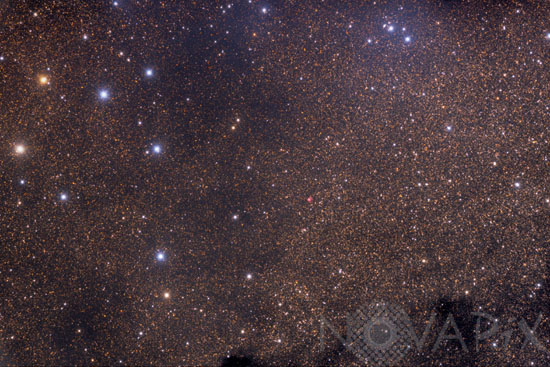Photo Agency - Astronomy - Space - Nature

Coathanger and nebula SH2-83 in Vulpecula
author: Tom Davis/Novapix
reference: a-neb85-08300
Image Size 300 DPI: 33 * 22 cm
Brocchi's Cluster (also known as the Coathanger or Collinder 399) is an asterism located in the constellation Vulpecula. It was first described by the Persian astronomer Al Sufi in his Book of Fixed Stars in 964 and was independently rediscovered by Giovanni Hodierna in the seventeenth century. In the 1920s, D. F. Brocchi, an amateur astronomer and chart maker for the American Association of Variable Star Observers, created a map of this object for use in calibrating photometers. The asterism is made up of ten stars ranging from fifth to seventh magnitude which form the conspicuous Coathanger, a straight line of six stars with a "hook" of four stars on the south side. An additional thirty or so fainter stars are sometimes considered to be associated as well. Under a dark sky, Brocchi's Cluster can be seen with the naked eye as an unresolved patch of light; binoculars or a telescope at very low power are usually needed in order to view the "coathanger" asterism. It is best found by slowly sweeping across the Milky Way along an imaginary line from the bright star Altair toward the even brighter star Vega. About one third of the way toward Vega, the Coathanger should be spotted easily against a darker region of the Milky Way. The status of this group as a star cluster has changed in recent years. The main stars were cataloged as an open cluster by Per Collinder in 1931, and the group was considered to be a cluster for most of the twentieth century. Looking at a variety of criteria, however, a study in 1970 concluded that only six of the brightest stars formed an actual cluster. Several independent studies since 1998 have now determined that this object is not a true cluster at all, but rather just a chance alignment of stars. These recent studies have generally based their findings on improved measurements of parallax and proper motion provided by the Hipparcos satellite which were first published in 1997.
This image also shows the small emission nebula Sh2-83 (near the center of the image) and the much fainter reflection nebula Lynds Bright Nebula 130 (bluish haze near top of image).
Contact : Stéphane Aubin +33-(0)9-51-26-53-76
© Novapix - All rights reserved


